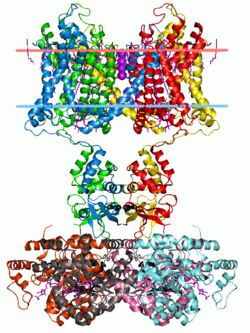
Back قناة بوتاسيوم Arabic Kalijski kanal BS Draslíkový kanál Czech Kaliumkanal Danish Kaliumkanal German Canal de potasio Spanish Canal potassique French Canle de potasio Galician Saluran kalium ID Canale del potassio Italian

Potassium channels are the most widely distributed type of ion channel found in virtually all organisms.[1] They form potassium-selective pores that span cell membranes. Potassium channels are found in most cell types and control a wide variety of cell functions.[2][3]
- ^ Littleton JT, Ganetzky B (April 2000). "Ion channels and synaptic organization: analysis of the Drosophila genome". Neuron. 26 (1): 35–43. doi:10.1016/S0896-6273(00)81135-6. PMID 10798390. S2CID 5694563.
- ^ Hille, Bertil (2001). "Chapter 5: Potassium Channels and Chloride Channels". Ion channels of excitable membranes. Sunderland, Mass: Sinauer. pp. 131–168. ISBN 978-0-87893-321-1.
- ^ Jessell TM, Kandel ER, Schwartz JH (2000). "Chapter 6: Ion Channels". Principles of Neural Science (4th ed.). New York: McGraw-Hill. pp. 105–124. ISBN 978-0-8385-7701-1.
© MMXXIII Rich X Search. We shall prevail. All rights reserved. Rich X Search